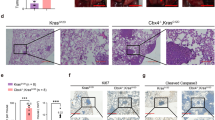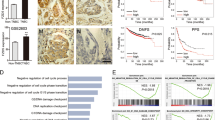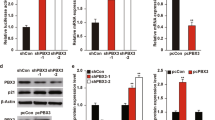Abstract
The polycomb group protein BMI1 has been shown to support normal stem cell proliferation via its putative stem cell factor function, but it is not known if BMI1 may also act as a cancer stem cell factor to promote cancer development. To determine the role of human BMI1 in cancer growth and survival, we performed a loss-of-function analysis of BMI1 by RNA interference (RNAi) in both normal and malignant human cells. Our results indicate that BMI1 is crucial for the short-term survival of cancer cells but not of normal cells. We also demonstrated that loss of BMI1 was more effective in suppressing cancer cell growth than retinoid-treatment, and surviving cancer cells showed significantly reduced tumorigenicity. The cancer-specific growth retardation was mediated by an increased level of apoptosis and a delayed cell cycle progression due to the loss of BMI1. By comparison, BMI1 deficiency caused only a moderate inhibition of the cell cycle progression in normal lung cells. In both normal and cancer cells, the loss of BMI1 led to an upregulation of INK4A-ARF, but with no significant effect on the level of telomerase gene expression, suggesting that other BMI1-cooperative factors in addition to INK4A-ARF activation may be involved in the BMI1-dependent cancer-specific growth retardation. Thus, human BMI1 is critical for the short-term survival of cancer cells, and inhibition of BMI1 has minimal effect on the survival of normal cells. These findings provide a foundation for developing a cancer-specific therapy targeting BMI1.
This is a preview of subscription content, access via your institution
Access options
Subscribe to this journal
Receive 50 print issues and online access
$259.00 per year
only $5.18 per issue
Buy this article
- Purchase on Springer Link
- Instant access to full article PDF
Prices may be subject to local taxes which are calculated during checkout



Similar content being viewed by others
References
Adhikary S, Eilers M . (2005). Nat Rev Mol Cell Biol 6: 635–645.
Al-Hajj M, Wicha MS, Benito-Hernandez A, Morrison SJ, Clarke MF . (2003). Proc Natl Acad Sci USA 100: 3983–3988.
Bea S, Tort F, Pinyol M, Puig X, Hernandez L, Hernandez S et al. (2001). Cancer Res 61: 2409–2412.
Blair A, Hogge DE, Ailles LE, Lansdorp PM, Sutherland HJ . (1997). Blood 89: 3104–3112.
Bruggeman SW, Valk-Lingbeek ME, van der Stoop PP, Jacobs JJ, Kieboom K, Tanger E et al. (2005). Genes Dev 19: 1438–1443.
Casillas MA, Brotherton SL, Andrews LG, Ruppert JM, Tollefsbol TO . (2003). Gene 16: 57–65.
Cohen KJ, Hanna JS, Prescott JE, Dang CV . (1996). Mol Cell Biol 16: 5527–5535.
Dimri GP, Martinez JL, Jacobs JJ, Keblusek P, Itahana K, Van Lohuizen M et al. (2002). Cancer Res 62: 4736–4745.
Haupt Y, Alexander WS, Barri G, Klinken SP, Adams JM . (1991). Cell 65: 753–763.
Itahana K, Zou Y, Itahana Y, Martinez JL, Beausejour C, Jacobs JJ et al. (2003). Mol Cell Biol 23: 389–401.
Jacobs JJ, Kieboom K, Marino S, DePinho RA, van Lohuizen M . (1999a). Nature 397: 164–168.
Jacobs JJ, Scheijen B, Voncken JW, Kieboom K, Berns A, van Lohuizen M . (1999b). Genes Dev 13: 2678–2690.
Kakunaga T, Yamasaki H . (1985). Transformation Assay of Established Cell Lines: Mechanisms and Applications. IARC Scientific Publications, International Agency for Research on Cancer: Lyon.
Leung C, Lingbeek M, Shakhova O, Liu J, Tanger E, Saremaslani P et al. (2004). Nature 428: 337–341.
Liu L, Berletch JB, Green JG, Pate MS, Andrews LG, Tollefsbol TO . (2004). Mol Cancer Ther 3: 1003–1009.
Mihara K, Chowdhury M, Nakaju N, Hidani S, Ihara A, Hyodo H et al. (2006). Blood 107: 305–308.
Molofsky AV, He S, Bydon M, Morrison SJ, Pardal R . (2005). Genes Dev 19: 1432–1437.
Molofsky AV, Pardal R, Iwashita T, Park IK, Clarke MF, Morrison SJ . (2003). Nature 425: 962–967.
Mori T, Kiyono T, Imabayashi H, Takeda Y, Tsuchiya K, Miyoshi S et al. (2005). Mol Cell Biol 25: 5183–5195.
Pardal R, Clarke MF, Morrison SJ . (2003). Nat Rev Cancer 3: 895–902.
Park IK, Qian D, Kiel M, Becker MW, Pihalja M, Weissman IL et al. (2003). Nature 423: 302–305.
Shakhova O, Leung C, Marino S . (2005). J Mol Med 83: 596–600.
Singh SK, Hawkins C, Clarke ID, Squire JA, Bayani J, Hide T et al. (2004). Nature 432: 396–401.
Takeda Y, Mori T, Imabayashi H, Kiyono T, Gojo S, Miyoshi S et al. (2004). J Gene Med 6: 833–845.
Terai M, Uyama T, Sugiki T, Li XK, Umezawa A, Kiyono T . (2005). Mol Biol Cell 16: 1491–1499.
van der Lugt NM, Domen J, Linders K, van Roon M, Robanus-Maandag E, te Riele H et al. (1994). Genes Dev 8: 757–769.
van Lohuizen M, Verbeek S, Scheijen B, Wientjens E, van der Gulden H, Berns A . (1991). Cell 65: 737–752.
Vonlanthen S, Heighway J, Altermatt HJ, Gugger M, Kappeler A, Borner MM et al. (2001). Br J Cancer 84: 1372–1376.
Acknowledgements
We would like to thank Amada Cunningham, Jessica Green, Joel Berletch, Serene Lai, and Drs Mitchell Pate and Richard Jope for help with some of the cell culture work. This work was funded in part by funding from the American Institute for Cancer Research (LL, Grant # 01A015) and an Evelyn F McKnight Brain Institute Grant (TOT).
Author information
Authors and Affiliations
Corresponding author
Rights and permissions
About this article
Cite this article
Liu, L., Andrews, L. & Tollefsbol, T. Loss of the human polycomb group protein BMI1 promotes cancer-specific cell death. Oncogene 25, 4370–4375 (2006). https://doi.org/10.1038/sj.onc.1209454
Received:
Revised:
Accepted:
Published:
Issue Date:
DOI: https://doi.org/10.1038/sj.onc.1209454
Keywords
This article is cited by
-
miR-15a/miR-16 down-regulates BMI1, impacting Ub-H2A mediated DNA repair and breast cancer cell sensitivity to doxorubicin
Scientific Reports (2017)
-
O-GlcNAcylation modulates Bmi-1 protein stability and potential oncogenic function in prostate cancer
Oncogene (2017)
-
BMI1 regulates PRC1 architecture and activity through homo- and hetero-oligomerization
Nature Communications (2016)
-
Cbx7 is epigenetically silenced in glioblastoma and inhibits cell migration by targeting YAP/TAZ-dependent transcription
Scientific Reports (2016)
-
Epigenetic mechanisms of tumorigenicity manifesting in stem cells
Oncogene (2015)



